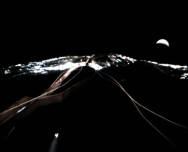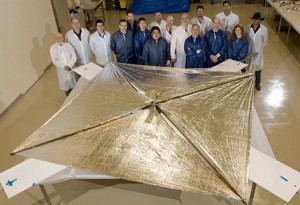
Good fortune continues to smile on Japan’s IKAROS solar sail. First of all, we can point to the image at left, a small shot to be sure but an amazing one nonetheless. Emily Lakdawalla explains on the Planetary Society’s blog that IKAROS’ transmitter is not powerful, so that it took a full two weeks to transmit the image from the spacecraft to Earth, and at that, it’s just a thumbnail. But take a look — what you see is the sail itself and, in the background, Venus. Think about it: A solar sail has successfully made an interplanetary crossing.
Yesterday the JAXA controllers behind the IKAROS mission confirmed that its first six months of life have been all but flawless, and the mission has been extended to March of 2012. This includes the deployment of its 20-meter diagonal, 0.0075 milimeter thick polyimide sail — you may remember that was a bit of a nail-biter from here because I was trying to translate tweets in Japanese and follow the incoming imagery, which at one point seemed to show a snarled cable. But that turned out to be a mis-reading, and full sail deployment was subsequently confirmed.
Almost as significant as actual deployment, though, was the success of the attitude control system JAXA built into the sail, which includes liquid crystal devices that can be turned on and off to vary the reflectivity of the sail, and thus creates changes in photon pressure for maneuvering. During the subsequent cruise operations on the way to Venus, IKAROS collected information on space dust and was used for very long baseline interferometry observations of deep sky objects. Up next: A suite of navigational studies, including varying the sail’s angle to the Sun and changing trajectory, maneuvers that will model the sail’s response for future missions.
The success of IKAROS to this point bodes well for the next major Japanese sail attempt, which will involve a sail ten times the size of this one paired with an ion propulsion unit on a mission to Jupiter. Launch is currently planned for 2019 or 2020, and this article in Science notes that there are plans to operate in conjunction with US and European missions to conduct joint observations of the giant planet. IKAROS mission manager Osamu Mori is looking ahead: “In half a year, we accomplished all the mission objectives. Now we’ve set new objectives.”
Tracking NanoSail-D
Meanwhile, NASA’s NanoSail-D is 650 kilometers up, having unfurled its own 10-meter square sail. Unlike IKAROS, NanoSail-D’s mission is much closer to home, according to principal investigator Dean Alhorn (NASA MSFC):
“Our mission is to circle Earth and investigate the possibility of using solar sails as a tool to de-orbit old satellites and space junk,” explains Alhorn. “As the sail orbits our planet, it skims the top of our atmosphere and experiences aerodynamic drag. Eventually, this brings it down.”
Atmospheric drag will indeed return NanoSail-D to Earth, where it will burn up in the atmosphere in 70 to 120 days. What’s ahead are useful observations measuring the effect of sunlight on the sail. It’s possible that atmospheric drag will mask the effect, but just how the orbit decays will help to answer that question. NanoSail-D may be the harbinger for future ‘drag sails’ that de-orbit satellites after their missions are over, a necessity given the amount of orbital debris building up around the Earth. But a successful sail deployment also gives hope to those who believe a robust future lies ahead for solar sailing as a way to move payloads around the inner system.
For those with an interest in seeing NanoSail-D, bear in mind that the sail is quite reflective. If Venus appears to us at an apparent magnitude of -5 at its brightest and the full Moon hits magnitude -13, NanoSail-D should be able to show up at -10, a substantial target when sunlight glints off the sail. A new contest encourages amateur photographers and astronomers to submit photos of the sail to help NASA monitor the condition of the spacecraft. A series of cash prizes are offered, with contest rules and a submission link at the site.
Image: The NanoSail-D team after a deployment test. Credit: NASA/MSFC.
Remember, too, that the NanoSail-D mission dashboard is here, while you can track satellite flybys at the spaceweather.com site. The contest has already begun and will end when the spacecraft re-enters the atmosphere in three months or so. So have some fun with NanoSail-D while it’s up there, and let’s hope that both it and IKAROS are joined soon by another solar sail in the form of the Planetary Society’s LightSail-1. The solar sail era is coming upon us, slowly but surely, and the advantages of leaving propellant behind will one day make these technologies indispensable.




Note that the prediction of an extremely bright NanoSail D – which initially read “five to 10 times as bright as the planet Venus, especially later in the mission when the sail descends to lower orbits” – has been purged from the SpaceWeather/NASA website which now only says that the “solar sail will occasionally be visible to the naked eye when sunlight glints off the spacecraft’s 10 m^2 sail.” There have been a handful of initial sighting reports so far which probably relate to the spacecraft, at between +2 and +7 mag., but the project has not confirmed that any of these are indeed of NanoSail D, and there hasn’t been anything new in the past few days.
Interesting news about IKAROS, has any details of accelerations or actual trajectory been released?
Has anyone got any data about the IKAROS thin film solar PV cells?
Of course IKAROS is a huge success, and extremely exciting. I’m not quite as excited about its “interplanetary crossing” seeing as the vast majority of the delta-v for its trajectory came from the boost that sent it and Akatsuki on their mutual way.
However, a real image of a working sail with Venus in the background is mighty hard to beat for pure cool.
I’m quite in agreement with Greg, and would love to learn about actual accelerations being applied to the sail. If I have time tonight I’ll try to check the JAXA site, though I’m sure my long-disused basic Japanese won’t be up to it if their technical material isn’t translated.
Greg, Alex and Istvan, there are some PDF materials in Japanese up on the site, but I have no further information on acceleration or the thin film cells, I’m afraid.
@ Istvan
is that true that for IKAROS the vast majority of the delta-v for its trajectory came from the boost that sent it and Akatsuki on their mutual way ? then
it’s kind of a fraud, is it not ?
Great article, C-D! This is the only place I’ve been able to get a good roundup of solar sail news. Keep the solar sail info coming and keep up the great work!
According to http://www.isas.jaxa.jp/home/IKAROS-blog/ IKAROS gained ~100m/s from sailing as of Jan 14th.
I really do wish people wouldn’t resort to words like “fraud”. That kind of thing starts to get you into legally-actionable territory. You are implying that the IKAROS team are deliberately trying to mislead, any evidence for that?
“fraud” was perhaps not the best choice – if you notice I was referring to
the post of @ Istvan where he said
” I’m not quite as excited about its “interplanetary crossing” seeing as the vast majority of the delta-v for its trajectory came from the boost that sent it and Akatsuki on their mutual way. ”
I was referring to the use of a chemical booster.
I am sure bill meant to say “cheating”, with tongue in cheek. Even so, it would have been too harsh.
I don’t think anyone meant to pretend we are sailing to Venus. The piggyback was a stroke of genius because it enables you to cheaply get up high enough so that the atmospheric drag does not negate the light pressure. Getting away from Earth entirely is an additional bonus, and getting close to Venus just more so. Getting there by sail power alone was not intended, not claimed, and is not the right choice of goal at this time.
NanoSail-D
Illustration Credit: courtesy NASA
Explanation: Featured in this artist’s illustration, NASA’s NanoSail-D finally unfurled a very thin, 10 square meter reflective sail on January 20th, becoming the first solar sail spacecraft in low Earth orbit. Often considered the stuff of science fiction, sailing through space was suggested 400 years ago by astronomer Johannes Kepler who observed comet tails blown by the solar wind. Modern solar sail spacecraft designs, like NanoSail-D or the Japanese interplanetary spacecraft IKAROS, rely on the small but continuous pressure from sunlight itself for thrust.
Glinting in the sunlight as it circles planet Earth, the NanoSail-D solar sail will periodically be bright and easily visible to the eye. In fact, skygazers are urged to participate in an ongoing contest to capture images of NanoSail-D. The images will help NASA monitor the satellite before it reenters the atmosphere in April or May.
http://apod.nasa.gov/apod/ap110128.html
Watch Out for Solar Sail Flares
February 1, 2011: It’s a calm and peaceful night. Stars twinkle in the velvety darkness overhead as a distant plane blinks silently on the horizon. You could almost hear a pin drop.
That is, until the flare.
High overhead, out of the darkness, a bright light surges into view. For 5 to 10 seconds it outshines the brightest stars in the sky, mimicking a supernova, perhaps even casting faint shadows at your feet. The silence is broken by your own excited shouts.
Could this happen to you?
“It could, if you happen to be outside when NanoSail-D flies by,” says Dean Alhorn of the Marshall Space Flight Center in Huntsville, AL. “We think the spacecraft could produce this kind of display from time to time when sunlight glints off the reflective fabric of its solar sail.”
On Jan. 21st, NanoSail-D unfurled a 10 m2 sail 650 km above Earth’s surface, becoming the first solar sail to orbit our planet. For the next few months it will skim the top of the atmosphere, slowly descending in a test of ‘drag sails’ as a means of de-orbiting space junk. If all goes as planned, the spacecraft will disintegrate like a meteor in April or May of 2011, dispersing harmlessly more than 100 km high.
Meanwhile, sky watchers should be alert for flares.
Full article and images here:
http://science.nasa.gov/science-news/science-at-nasa/2011/01feb_solarsailflares/
Try to observe Nanosail-D with your own eyes before it burns up in Earth’s atmosphere:
http://www.universetoday.com/85215/last-best-chances-to-see-nanosail-d/
NanoSail-D Caught on Video
by Nancy Atkinson on May 11, 2011
When you have an automated video camera, its amazing what you can pick up in the night sky. Dr. Robert Suggs used the Automated Lunar and Meteor Observatory at Marshall Space Flight Center to catch NanoSail-D on video as it slipped across the sky back on March 2nd, 2011.
This video is from the small finder camera for the observatory and the solar sail appears just how it would be seen by the the naked eye. The NanoSail-D twitter feed said that this video is actually upside down.
“I am actually sailing out of the trees and higher into the night sky,” the solar sail Tweeted. The same facility also captured images of NanoSail-d with 80mm and 14? telescopes.
NanoSail-D won’t be visible for very much longer, just a couple of weeks or less until it will burn up in the atmosphere. See our previous article on how to observe NanoSail-D before it de-orbits.
Full items here:
http://www.universetoday.com/85581/nanosail-d-caught-on-video/